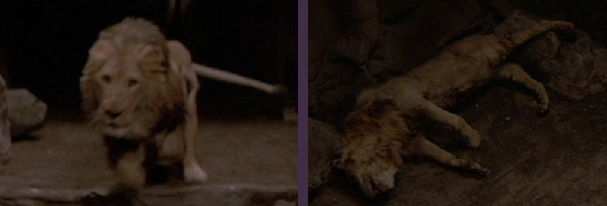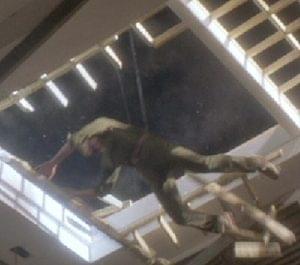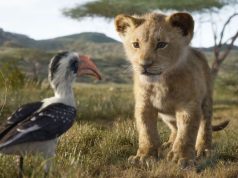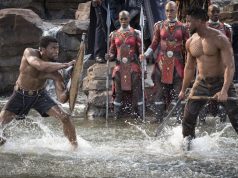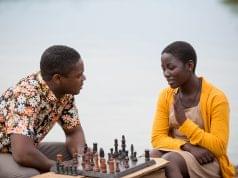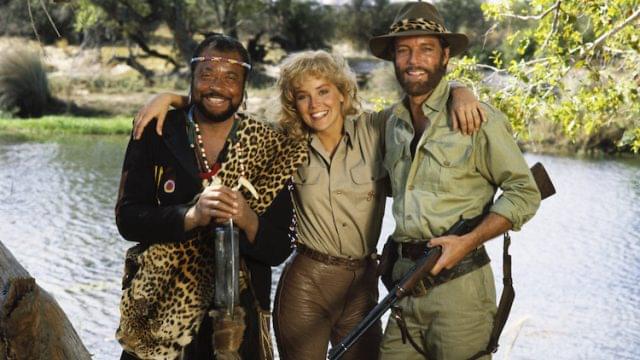
Like most popular things, the Indiana Jones movies have inspired many copycats and rip-offs. The most recent was something called “Kingdom of the Crystal Skull,” in which an 80-year-old Harrison Ford lookalike battled cartoon ants with the kid from “Even Stevens.” But back in the 1980s, when Indy-mania was at its peak, savvy, penny-pinching filmmakers slapped together films like “King Solomon’s Mines” and its sequel, “Allan Quatermain and the Lost City of Gold.” These films may have been laughably bad, with absurdly cheap special effects, but one thing’s for sure: They sort of reminded some people of Indiana Jones, kind of!
We turn our attention today to the sequel, the one about the lost city of gold. (How do you lose a whole city?? Especially one made of gold! This is why we can’t have nice things.) Both films are based on books by H. Rider Haggard, which the opening credits of “Lost City of Gold” remind us of in this fashion: “Based on H. Rider Haggard’s best-selling classic novel,” which seems to be overstating the case. “It’s based on a book that was very, very popular! It’s a classic! Everyone loved it! Seriously! This movie is gonna be AWESOME!”
The setting is Africa (I’m sorry I can’t be more specific), and the time is a while ago (ditto). Allan Quatermain (Richard Chamberlain) is a suave, beardy explorer guy with no discernible source of income. When we meet him, he is skeet-shooting with some African kids, using tomatoes instead of clay pigeons. Then he says, “Now try some tomatoes,” even though that’s what they were already doing — apparently, the director used two different takes of the same scene to make it appear twice as long. And we’re off to a good start!
Quatermain’s girlfriend is Jesse Huston, played by a then unknown Sharon Stone in her pre-“Basic Instinct,” panty-wearing days. If you thought Kate Capshaw was annoying in “Indiana Jones and the Temple of Doom,” well … you’re right. She was. Hoo-boy, was she ever! But so is Jesse Huston, and for all the same reasons: she’s ditzy, she screams too much, and she’s terrified of all the things that, as the girlfriend of an explorer, she must encounter on a daily basis.
Quatermain and Jesse are supposed to be sailing to America to get married, but a more urgent matter comes up when Quatermain learns his brother has gone missing while searching for the aforementioned lost city of gold. So, great, now Quatermain has to find the lost city AND the lost brother. On the bright side, it saves him from enduring an ocean voyage with Jesse. Unfortunately, she opts to tag along for the perilous journey into the uncharted regions of Africa.
They are joined in their quest by two locals. One is a local tribal warrior named — I’m serious — Umslopogaas, played by James Earl Jones. He is fierce and noble and carries a large axe. The other is a greedy, duplicitous shaman named Swarma, played by Robert Donner, whom you may recall from “Mork & Mindy,” where he played Mork’s crazy friend Exidor. Robert Donner excelled at playing grating, unfunny supporting characters. Swarma is the kind of sniveling, over-acting buffoon that you hope will be eaten by a lion or fall into quicksand or something, but you know he won’t because he’s the comic relief and movies like this never kill off the comic relief. That is one of the problems with movies like this.
The four embark on their trek, accompanied by several nameless tribesman as guides, all of whom die along the way. (Screenwriter’s logic: “We need the guides to help them make the journey, but we don’t want to have too many characters to keep track of when they finally arrive….”) The journey to the lost city of gold is treacherous, full of such booby-traps and surprises as: grass-covered plywood floors that open beneath them; stock footage of dangerous animals; perilous river rapids projected onto a green screen; and rubber snakes.
There is also an attack by a lion, the kind of lion that lives in dark, sunless caves. Perhaps it is a bat-lion. What’s amazing about this lion is that it’s perfectly healthy when Quatermain shoots it, but shriveled and desiccated afterward:
Quatermain, Jesse, Umslopogaaas, and Swarma eventually find the lost city of gold, and sure enough, it’s awesome. There’s a race of white people living there, intermixed with the natives, and Quatermain’s brother, Robeson, is happily among them. (Interesting bit of true trivia: Robeson is played by Martin Rabbett, who was — and still is — Richard Chamberlain’s domestic partner. Which means Quatermain wasn’t just searching for his brother — he was searching for his boyfriend. Take that, Sharon Stone!)
Everyone lives in peace and harmony, except that there’s a crazy-haired guy named Agon (Henry Silva) who has appointed himself high priest and instituted the practice of human sacrifices. Nobody likes it, though, and they want it to stop. How Agon talked them into it in the first place, I have no idea. I also have no idea why, if everyone wants to overthrow Agon, they don’t just, you know DO IT. There’s only one of him and like a thousand inhabitants of the lost city. What, does Allan Quatermain have to do EVERYTHING around here?! How did Africa ever manage without him?
Oh, I forgot to mention that along the way, Quatermain shot another lion. He really has a thing about lions, I guess, and his gun is the answer to all of life’s problems.
Having gotten us to the lost city of gold with 40 minutes still on the clock, the movie has to come up with something for everyone to do. (I bet they wish they hadn’t killed all those guides! They could have provided subplots.) That means there’s a battle with Agon, and multiple instances of Quatermain and his crew making the natives think they’re gods because they have dynamite, and plenty of cheesy stunts and questionable special effects. My favorite is when Quatermain crashes through a skylight and the filmmakers make no attempt whatsoever to hide the thick cables carrying him:
Or, more optimistically, perhaps they DID make a serious attempt to hide the cables, and this was the best they could do. Maybe the cables were actually a foot in diameter apiece and what we see here is the result of hours of painstaking post-production trickery. Let’s go with that. To be fair, sometimes you can see the wires holding up Harrison Ford when he walks, too.
— Film.com


